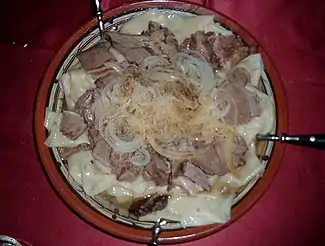Beshbarmak
Beshbarmak (Kazakh: бешбармак — "five finger") is the national dish among nomadic Turkic peoples in Central Asia and Russia. It is also known as naryn in Xinjiang, Uzbekistan, Kyrgyzstan and Kazakhstan, as turama or dograma in Karakalpakstan, North Caucasus and Turkmenistan, and as kullama in Bashkortostan and Tatarstan.

The term beshbarmak means "five fingers[1]", because nomads traditionally eat this dish with their hands. Beshbarmak is usually made from finely chopped boiled meat, mixed with noodles and chyk, an onion sauce. It is typically served on large communal platters, shared between several people,[2] after shorpo, which is a first course of mutton broth served in bowls called kese. It is also followed by a broth called ak-serke[3] (shorpo mixed with kymyz or ayran), which is thought to help with settling the stomach.[4] Festive beshbarmak can be cooked together with kazy and chuchuk.
Historical background
The cuisine of Central Asia developed within the constraints of a nomadic life, when people were completely reliant on their animals. This is reflected in Central Asian dishes, which are rich in meat and dairy products.[5]
The serving ritual
The serving of beshbarmak is steeped in ritual. If an animal, such as a sheep, was slaughtered in a guest's honor, then the host serves ustukan, different cuts of meat, to different people, depending on their gender, age, and rank in the social structure. As a sign of respect, the oldest people and honored guests are always presented the prime cuts of the meat.

On special occasions, the guest of honor, the eldest male, or the youngest male, receives the bash, the head of the animal, and cuts pieces from it to distribute to other people. The oldest men or aksakal receives the jambash,[5] the thigh bone. The oldest and most respected women receive the kuiruk or kuymulchak, the tailbone. The legs and shoulders are presented to the younger adults, and the smaller bones are reserved for the daughter-in-law of the house. The omurtka, the spine, is given to the children.
Other ustukans include the joto jïlïk, tibia or shin bone, the kashka jïlïk, thigh or femur bone, the bone from rib to thigh called the karchiga, a rib without fat called the kara kabirga, the kar jïlïk or radius bone, dalii or shoulder blade, the toshi, breast or brisket, and the kung jïlïk, bone from the leg to the shoulder blade.[4]
Preparation
In the classic variant of beshbarmak, as it is now prepared in northern Kyrgyzstan (especially in the Naryn region), a good, sharp knife called maki (Kyrgyz: маки) is required, to thinly dice all the ingredients before they are put on the dastarkhan. The dish also requires a pot to boil the meat and noodles in, and a rolling pin to roll out the noodles, also the use forks with five needles on it to help with the tradition
Beshbarmak is prepared by first boiling a piece of meat, such as the rump of a horse, or a rack of lamb, or kazy or chuchuk horsemeat sausage. In warm seasons, beshbarmak is usually made with mutton.
The noodle dough is made from flour, water, eggs, and salt, and rested for 40 minutes. Then the dough is rolled out very thinly, and cut into noodles.[5]
References
- "Beshbarmak | Traditional Meat Dish From Kazakhstan | TasteAtlas". www.tasteatlas.com. Retrieved 2020-01-22.
- "Understanding Identity and Kyrgyz Cultural Values Through Food". National Geographic.
- ""Special Beshbarmak" in Bishkek". srasstudents.org. 2013-06-20. Retrieved 2020-01-22.
- Hays, Jeffrey. "KYRGYZ DISHES, RESTUARANTS[sic] AND SHEEP | Facts and Details". factsanddetails.com. Retrieved 2020-01-22.
- "Beshbarmak: Five Finger Food". Edge : Kazakhstan. 2015-05-26. Retrieved 2020-01-22.